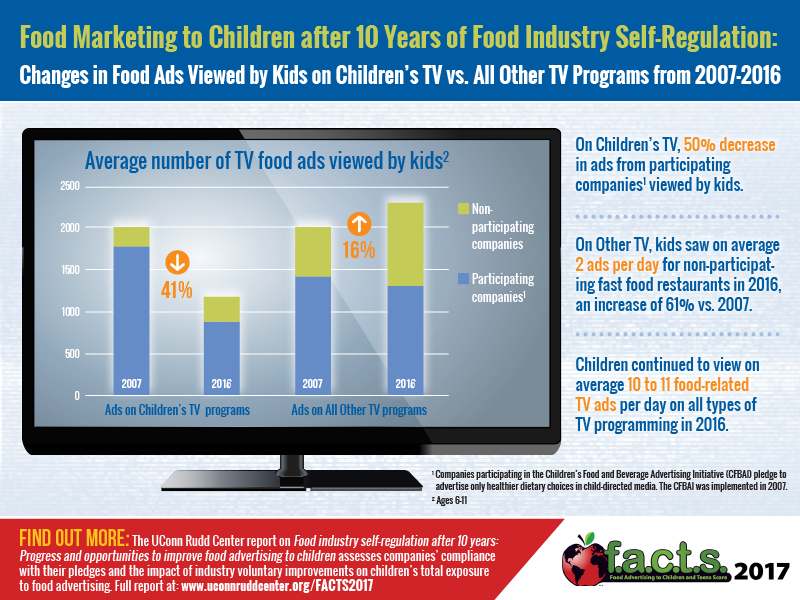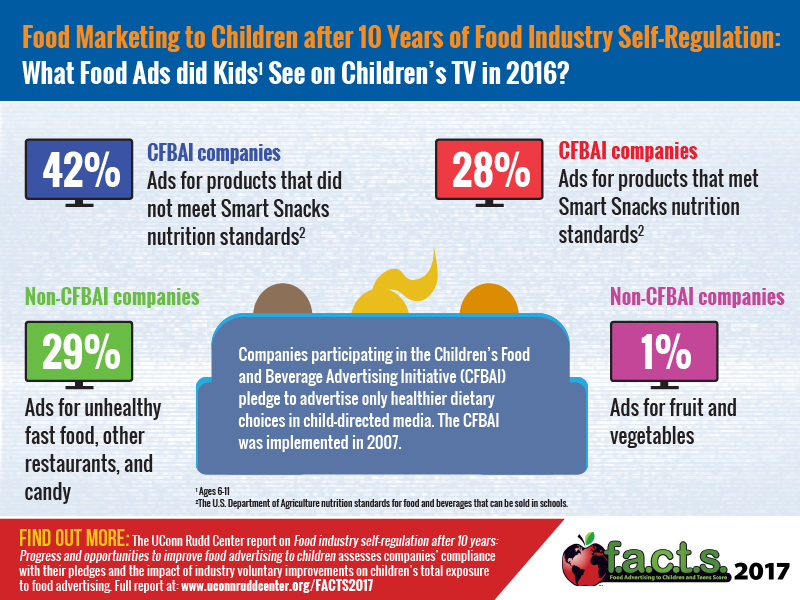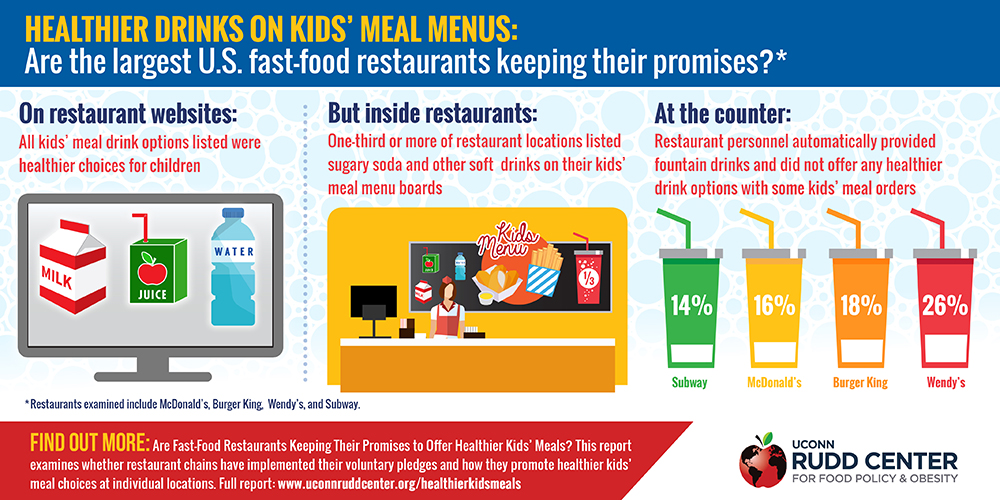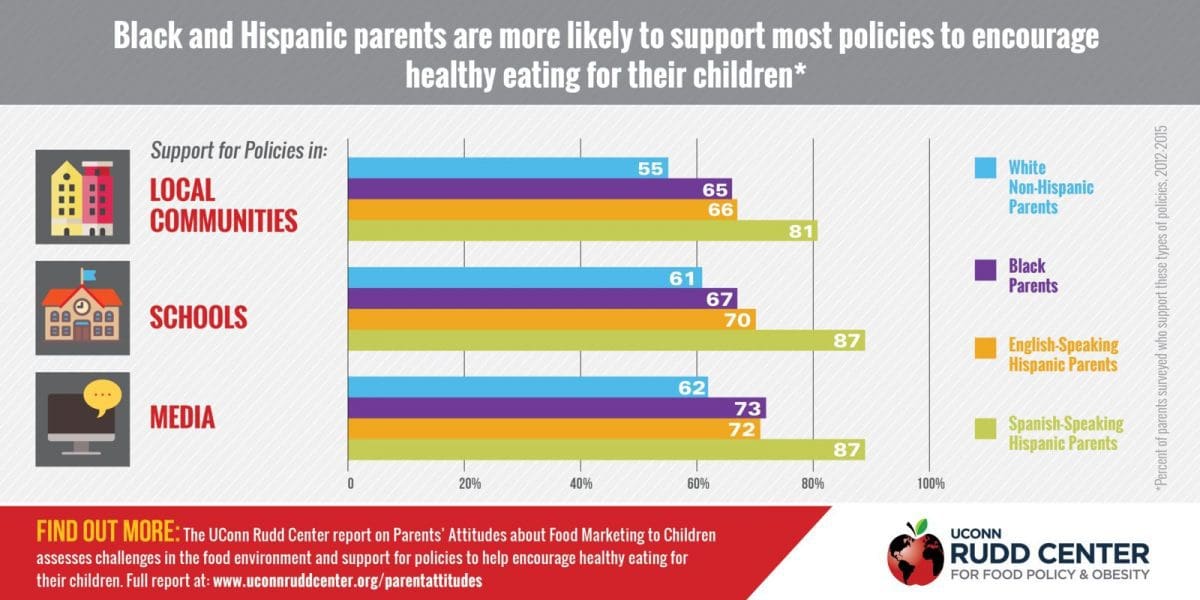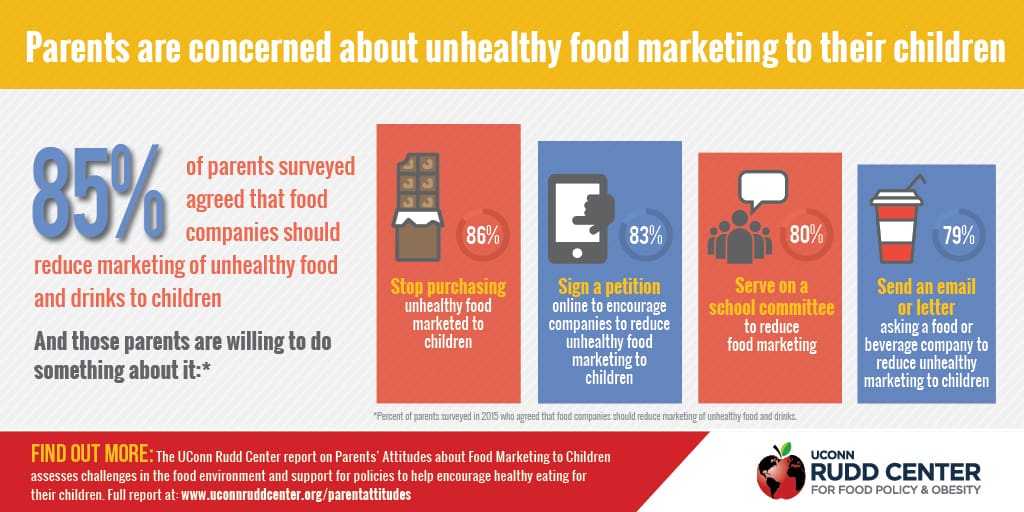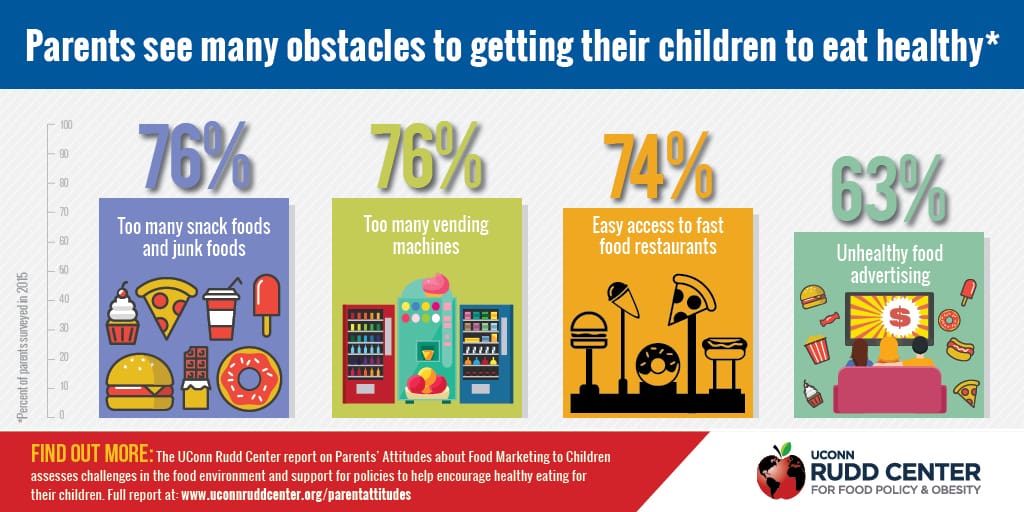Policy & Advocacy
The massive amount of marketing for unhealthy food and drinks aimed at children and teens poses significant long-term risks to their health. Food and beverage companies disproportionately target advertising for many of their least nutritious brands to Black and Hispanic youth. In the absence of effective food industry self-regulation, advocates and policymakers are pursuing a variety of policy-driven strategies to protect all children from the unhealthy influence of food marketing.
Use the resource links below to explore policy, legal & regulatory actions to reduce unhealthy food and beverage marketing.
Learn More
Government Policies
Research:
- Fleming-Milici, F. (2024). Policy Brief: Energy Drink Regulation - Protecting Youth from Dangerous Products.
- Pomeranz, JL & Harris, J.L. (2020). Children’s fruit “juice” drinks and FDA regulations: Opportunities to increase transparency and support public health. American Journal of Public Health, in press.
- Emond J, Fleming-Milici F, McCarthy J, et al. (2020). Unhealthy Food Marketing on Commercial Educational Websites: Remote Learning and Gaps in Regulation. Am J Prev Med. 2021;60(4):587-591.
- Harris JL, Pomeranz JL. Infant formula and toddler milk marketing: opportunities to address harmful practices and improve young children’s diets. Nutr Rev. 2020;78(10):866-883.
- Harris, J.L., Webb, V., Sacco, S.J. & Pomeranz, J.L. (2020). Marketing to children in the supermarket: An opportunity for public policy to support parents and improve children’s diets. International Journal of Environment and Public Health, 17, 1284; Doi:10.3390/ijerph17041284.
- Asada, Y., Chriqui, J., Schwartz, M., Mancini, S. & Harris, J.L. (2020). Food and beverage marketing in schools: Understanding school superintendents’ perspectives and practices after the Healthy, Hunger-Free Kids Act. Public Health Nutrition, in press.
- Choi, Y-Y, Ludwig, A., Andreyeva T. & Harris, J.L. (2020). Effects of US WIC infant formula contracts on brand sales of infant formula and toddler milks. Journal of Public Health Policy, in press.
- Pomeranz, J.L., Romo-Palafox, M.J., & Harris, J.L. (2018). Toddler drinks, formulas, and milks: Labeling practices and policy implications. Preventive Medicine, published online.
- Policy changes to reduce unhealthy food and beverage marketing to children in 2016 and 2017. Rudd Brief. April 2018.
- Pomeranz, J.L., Munsell, C., & Harris, J.L. (2013). Energy drinks: An emerging public health hazard for youth. Journal of Public Health Policy, 34(2), 254-271.
- Harris, J.L. & Graff, S.K. (2012). Protecting Young People From Junk Food Advertising: Implications of Psychological Research for First Amendment Law. American Journal of Public Health, 102(2), 214-222.
- Pomeranz, J. (2012). Extending the fantasy in the supermarket: Where unhealthy food promotions meet children and how the government can intervene. Indiana Health Law Review. 9(1):117-185
- Harris, J.L. & Graff, S.K. (2011). Protecting children from harmful food marketing: Options for local government to make a difference. Preventing Chronic Disease, 8(5).
- Pomeranz, J. (2010). Television food marketing to children revisited: The Federal Trade Commission has the constitutional and statutory authority to regulate. Journal of Law, Medicine & Ethics. 38(1):98-116.
- Harris, J.L., Brownell, K.D. & Bargh, J.A. (2009). The Food Marketing Defense Model: Integrating psychological research to protect youth and inform public policy. Social Issues and Policy Review, 3, 211-271.
Industry Self-Regulation
Research:
- Jensen, M. L., McCann, M., Fleming-Milici, F., Mancini, S., & Harris, J. L. (2022). FACTS 2022 Food industry self-regulation: Changes in nutrition of foods and drinks that may be advertised to children. UConn Rudd Center for Food Policy & Health.
- Jensen, M. L., Fleming-Milici, F., Mancini, S., McCann, M., & Harris, J. L. (2022). P059 Food Industry Self-regulation: Nutrition Quality of Products Marketed to Children Before and After Revised Nutrition Criteria. Journal of Nutrition Education and Behavior, 54(7), S46. https://doi.org/10.1016/j.jneb.2022.04.099
- Fleming-Milici, F. & Harris, J.L. (2020). Food marketing to children in the United States: Can industry voluntarily do the right thing for children’s health? Physiology & Behavior, in press.
- FACTS 2017. Food industry self-regulation after 10 years: Progress and opportunities to improve food advertising to children. November 2017.
- FACTS 2017 summary.
- Boyland, E.J. & Harris, J.L. (2017). Regulation of food marketing to children: are statutory or industry self-governed systems effective? Public Health Nutrition, 20(3), 761-764.
- Harris, J.L., LoDolce, M.E., Dembek, C. & Schwartz, M.B. (2015). Sweet promises: Candy advertising to children and implications for food industry self-regulation. Appetite, 95(1), 585-592.
- Harris, J.L., LoDolce, M.E., & Schwartz, M.B. (2014). Encouraging Big Food to do the right thing for children’s health: A case study on using research to improve marketing of sugary cereals. Critical Public Health, 25(3), 320-332.
- Harris, J.L., Sarda, V., Schwartz, M.B., & Brownell, K.D. (2013). Redefining “child-directed advertising” to reduce unhealthy television food advertising. American Journal of Preventive Medicine, 44(4), 358-364.
- Powell, L.M., Harris, J.L., & Fox, T. (2013). Food marketing expenditures aimed at youth: Putting the numbers in context. American Journal of Preventive Medicine, 45(4), 453-461.
- Hawkes, C. & Harris, J.L. (2011). An analysis of the content of food industry pledges on marketing to children. Public Health Nutrition, 14(8); 1403-1414.
Infographics:
Healthier Kids’ Meals
Research:
- Parents’ report of fast-food purchases for their children: Have they improved? Rudd Report. September 2018.
- Are fast-food restaurants keeping their promises to offer healthier kids’ meals? Rudd Report. August 2017.
- Fast Food FACTS. Measuring progress in nutrition and marketing to children and teens. November 2013.
- UConn Science in Seconds video: The Truth about Fast-Food Kids’ Meals
Infographic:
Parents’ Attitudes About Food Marketing to Children
Research:
- Fleming-Milici, F., Harris, J.L., & Liu, S. (2018). Race, Ethnicity, and Other Factors Predicting U.S. Parents’ Support for Policies to Reduce Food and Beverage Marketing to Children and Adolescents. Health Equity, 2:1, 288-295.
- Parents’ attitudes about food marketing to children: 2012 to 2015. Rudd Report. April 2017.
- Cognitive interviews to validate survey items. Rudd Brief. August 2014.
- Food Marketing to Children and Adolescents: What do Parents Think? 2009-2011. Report, Questionnaire, Policy Recommendations
- Focus groups with parents: What do they think about food marketing to their kids? Rudd Report. May 2010.
- Goren, A., Harris, J.L., Schwartz, M.B. & Brownell, K.D. (2010). Predicting support for restricting food marketing to youth. Health Affairs, 29(3), 419-424.
Rudd Summaries:
- Parents’ support for community-based policies
- Parents’ support for media-related policies
- Parents’ support for school-related policies
Infographics:
Sugary Drink Taxes
Concerned policy makers, community leaders, and public health professionals across the country are considering a variety of policies to reduce consumption of sugary drinks, including legislation to levy excise taxes on these products. Since November 2014, Mexico and eight U.S. local governments, including Berkeley and San Francisco, CA, Seattle, WA, and Philadelphia, PA, have adopted sugary drink taxes. Research indicates that if sugary drink taxes are large enough they can reduce consumption. In addition, the public health community is calling for the revenue from these taxes to be used on obesity prevention, anti-hunger, early care and education, and health and wellness initiatives.
Food Marketing in Schools
In 2016, the U.S. Department of Agriculture implemented new rules that prohibit marketing of products that do not meet nutrition standards to children and teens in schools during the school day. However, food companies continue to market sugary drink and junk food brands to children through their schools, including through branded fundraisers, “educational” materials, incentives for teachers, and sponsorships. Sales of branded “look-alike” snacks in schools also allows companies to market junk food in schools.
